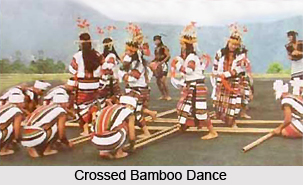 Crossed bamboo dance is a regional dance of the North-Eastern Indian state of Mizoram and is locally referred to as `Cheraw Dance`. Four people are involved in this dance form, who hold two pairs of bamboo staves on top of one another in a criss-cross pattern, on the ground. This dance is performed in several regional festivals of Mizoram.
Crossed bamboo dance is a regional dance of the North-Eastern Indian state of Mizoram and is locally referred to as `Cheraw Dance`. Four people are involved in this dance form, who hold two pairs of bamboo staves on top of one another in a criss-cross pattern, on the ground. This dance is performed in several regional festivals of Mizoram.
Long bamboo staves are placed in horizontal as well as cross manner on the ground, during this dance. Male dancers are responsible for shifting the bamboo staves and altering their positions in rhythmic beats, while female dancers of Cheraw dance move rhythmically in between the staves, by stepping in and out of the bamboo poles. Crossed bamboo dance is believed to be one of the most ancient regional dances of the area of Mizoram and have originated in the 1st century A.D. Since bamboo staves are utilized in this particular dance, it is referred to as crossed bamboo dance. In olden days, this dance was performed as it was said that doing so would comfort the soul of a deceased mother who had died, leaving her newborn child behind.
The male dancers clap the bamboo poles together, while female dancers move gracefully amongst the bamboo staves, in perfect harmony with the constant moving of the bamboos. The female dancers are dexterous and are equipped with sound knowledge about the rhythm and time, which is essential for this kind of dance. Alternative dance steps are followed, in which the Cheraw dancers shift elegantly across the horizontally placed and crossed bamboo staves. The men, sitting on either sides, produce a sound by clapping the bamboos together in rhythmic beats. This also enables the dancers to keep count of the time. The bamboos on the other hand keeps moving backwards and forwards to the same tune hence the dancer has to be very fast to avoid being caught in one or other of the squares. The dance is very fascinating to watch but the dancer needs to well skilled to perform the dance.
`Puanchei`, `Vakiria`, `Kawrchei` and `Thihna` are the traditional costumes which are clad by the female dancers of Cheraw. These garments are quite colourful and impart a spectacular ambience to the festivals or events where the dance is being performed. Most of the dance movements of the crossed bamboo dance are motivated by nature. For instance, a few expressions in this dance imitate the swaying of trees, while some others resemble the flying of birds.



















